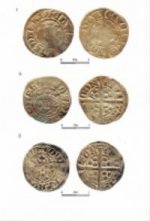Satori
Full Member
Published Date: 11 November 2008
By Kate Forrester
A Flintshire history enthusiast, who uncovered three 700-year-old coins, is delighted after having his findings officially declared treasure.
Peter Barker Jones, of Holywell, was exploring a field owned by his friend in July 2006, when he came across a silver coin on the surface of the ground.
Mr Jones, who says he has always been interested in local history and archaeology, was searching for old flint tools, where he believes there was the site of a Neolithic camp, when he happened across the object.
He said: "I regularly look for flint tools on the field, and another one next to it, and I have found about a hundred old knives and arrow heads, which I think are from between 8,000 and 2,000 BC.
"I don't ever use metal detectors. I just found the coin on the surface.
"It wasn't buried under anything and it was in good condition.
"I only had to rub it with my fingers and it was practically clean."
An inquest into the find, held in Flint on Monday, heard that Mr Jones returned to the field, which is owned by his friend, Ron Davies, on February 28, 2007, to search for more tools, when he discovered a second coin.
The pair were shocked when Mr Jones returned again on March 3, to uncover his third and final coin.
Mr Jones added: "I declared the coins to the archaeological society in Denbighshire and followed all the proper procedures to say what I had found.
"I knew they were probably pennies from the Edwardian age, but I didn't know what would happen to them at the time, or how much they were worth."
The coins were sent to National Museums Wales, where experts examined them and confirmed they were silver pennies, from the reign of Edward I and Edward II, from 1309-1327.
The report stated that two of the coins were minted in London and one in Canterbury, and they are all believed to be made from silver with about 90 per cent purity.
Under the Treasure Act 1996, findings can be declared treasure if they contain more than 10 per cent pure gold or silver, and are more than 300 years old when found.
The royalties from objects declared treasure are usually split between the finder and the landowner.
Based on the evidence provided by National Museums Wales, north east Wales deputy coroner John Gittins said he was happy to officially declare the coins treasure.
Mr Jones is now deciding whether to display his valuable find for everyone to see.
He said: "I know Flintshire County Museums Service have said they are interested in the coins, but I am not sure what I'll do with them yet. It depends how many offers I get!"
Evening Leader Flintshire newspaper.
By Kate Forrester
A Flintshire history enthusiast, who uncovered three 700-year-old coins, is delighted after having his findings officially declared treasure.
Peter Barker Jones, of Holywell, was exploring a field owned by his friend in July 2006, when he came across a silver coin on the surface of the ground.
Mr Jones, who says he has always been interested in local history and archaeology, was searching for old flint tools, where he believes there was the site of a Neolithic camp, when he happened across the object.
He said: "I regularly look for flint tools on the field, and another one next to it, and I have found about a hundred old knives and arrow heads, which I think are from between 8,000 and 2,000 BC.
"I don't ever use metal detectors. I just found the coin on the surface.
"It wasn't buried under anything and it was in good condition.
"I only had to rub it with my fingers and it was practically clean."
An inquest into the find, held in Flint on Monday, heard that Mr Jones returned to the field, which is owned by his friend, Ron Davies, on February 28, 2007, to search for more tools, when he discovered a second coin.
The pair were shocked when Mr Jones returned again on March 3, to uncover his third and final coin.
Mr Jones added: "I declared the coins to the archaeological society in Denbighshire and followed all the proper procedures to say what I had found.
"I knew they were probably pennies from the Edwardian age, but I didn't know what would happen to them at the time, or how much they were worth."
The coins were sent to National Museums Wales, where experts examined them and confirmed they were silver pennies, from the reign of Edward I and Edward II, from 1309-1327.
The report stated that two of the coins were minted in London and one in Canterbury, and they are all believed to be made from silver with about 90 per cent purity.
Under the Treasure Act 1996, findings can be declared treasure if they contain more than 10 per cent pure gold or silver, and are more than 300 years old when found.
The royalties from objects declared treasure are usually split between the finder and the landowner.
Based on the evidence provided by National Museums Wales, north east Wales deputy coroner John Gittins said he was happy to officially declare the coins treasure.
Mr Jones is now deciding whether to display his valuable find for everyone to see.
He said: "I know Flintshire County Museums Service have said they are interested in the coins, but I am not sure what I'll do with them yet. It depends how many offers I get!"
Evening Leader Flintshire newspaper.




